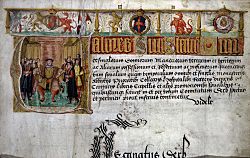Valor Ecclesiasticus facts for kids
Quick facts for kids Valor Ecclesiasticus |
|
|---|---|
| The National Archives, Kew, London | |

Title page
|
|
| Date | 1535 |
The Valor Ecclesiasticus (which means "church valuation" in Latin) was a huge survey of the church's money. It covered England, Wales, and parts of Ireland. King Henry VIII ordered this survey in 1535. People sometimes called it the Kings books.
Contents
Why the Survey Was Needed
In 1534, King Henry VIII made a big change. He decided to break away from the Pope and the Roman Catholic Church. He then made himself the head of the church in his own lands. This was done through a law called the Act of Supremacy.
One of his first actions as the new church head was to collect taxes from the clergy. Clergy are church officials like priests and bishops. Before, these taxes went to the Pope. Now, King Henry wanted them for himself.
He also decided to create a new annual income tax. This tax was 10% of the money earned from all church lands and jobs. To figure out how much tax everyone owed, he needed to know exactly how much money the church had. That's why the Valor Ecclesiasticus survey was so important.
How the Survey Was Done
In January 1535, the government chose special groups of people called commissions. These groups were sent all over the country. Their job was to carry out the survey.
All church leaders had to report their income. This included parish priests, heads of monasteries, colleges, and hospitals. They had to swear an oath and tell the commissioners about their money. They also had to list the lands their churches owned. They had to report all other ways they received money.
The commissioners checked documents and account books. They used this information and the sworn statements. From all this, they created a full financial report for every religious place. The government wanted all this information by May 30, 1535. The results were sent to the Exchequer in London, which was like the government's treasury.
The Survey's Results
The people who worked as commissioners were not paid. They were also not specially trained for this job. Most were local gentry (important landowners), mayors, magistrates, bishops, and sheriffs.
Even so, they worked very quickly. By the summer of 1535, the government had a detailed record. It showed all the property and wealth of the church. Most of their work still exists today. It is kept in 22 Latin books and three folders. You can find them at The National Archives in Kew. Two of these books are beautifully decorated. They seem to be a summary made just for King Henry.
How Accurate Was It?
The commissioners had no special reason to favor the church. They worked very carefully. When we compare their numbers to other records, they seem mostly correct. For example, later records from officials who closed down monasteries show similar figures.
Sometimes, the survey's numbers were a bit lower. For instance, the value of some farmland or forests might have been underestimated. This could be because people naturally try to report less income for taxes. Also, the survey was done very quickly. So, the commissioners might have given the church the benefit of the doubt.
In a few rare cases, the numbers were very wrong. This might mean someone tried to cheat. For example, at Norton Priory in Cheshire, the reported income was so low. Because of this, the abbey was chosen to be closed down early. This happened under the first law for the dissolution of smaller religious houses in 1536.
Why the Survey Was Important
The Valor Ecclesiasticus was very important for King Henry. For the first time, his government truly understood how rich the church was. They especially learned about the wealth of the monasteries.
It wasn't long before King Henry started making plans. He wanted to take much of this wealth for himself. He began with the smaller religious houses. The numbers from the Valor were key to this plan. They helped him decide which monasteries to close first.
This survey was a vital part of the Suppression of Religious Houses Act 1535. This law dissolved, or closed down, all monasteries that earned less than £200 per year. This was Henry's first step in the larger dissolution of the monasteries.
The Valor is a very important document for historians. It helps them understand the church in the later medieval and Tudor times. It also sheds light on the English Reformation and the Dissolution of the Monasteries. It is also valuable for people who study economic history from that time.

